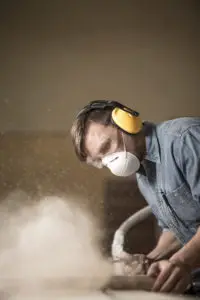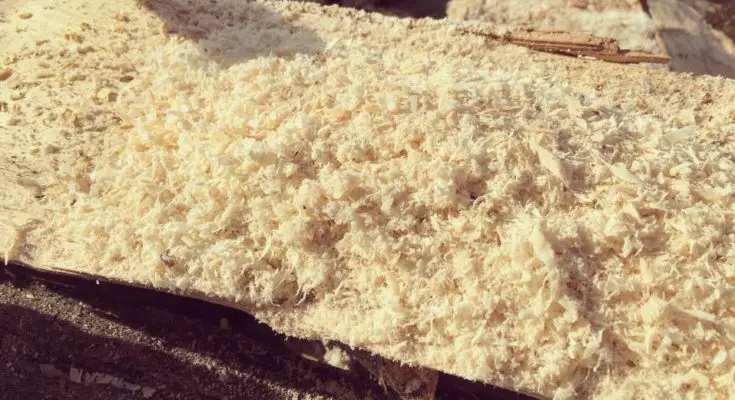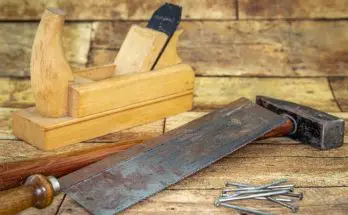For any person with a wood workshop – or even a garage where you plan on doing some woodwork – knowing what size dust collector you need is vital to keep your workspace clean and yourself healthy. Inhaling fine dust is the cause of severe respiratory issues, allergies, and can even shorten your life. It might sound drastic, but it’s true.
The EPA has put strict rules in place to protect workers who spend all day in a workshop. By a number of estimations, workers in a woodshop without proper ventilation and dust collection lose a percentage of their respiratory capacity each year they work in an improperly vented environment. Over a lifetime, you can reduce your lifespan by as much as ten years! If that’s not a reason to ensure proper dust collection, I don’t know what is.
So, this begs the question, how much dust collection do you need? You can run the risk of not having enough collection, but is there such a thing as too much? Whether you have a small shop or a large garage, figuring out how much dust collection you need is simply a matter of numbers. But first of all, let’s break down what dust collection is.
Dust Control Equipment
Before we get into what size dust collector you need, I think it’s important to make sure you fully understand the different types of equipment available to reduce the amount of sawdust in your shop. Each of these pieces of equipment have a specific role, and sometimes this can cause confusion amount new woodworkers.
- Shop-Vac – If you’ve done any woodworking or even own a garage, there’s a high probability that you own a shop vacuum (Shop-Vac). These units are designed to vacuum up and sawdust, dirt and other garbage from your area. They can come in many different sizes. You can pick one up for as little as $60 and pay on up to a few hundred dollars if you choose. The great thing about shop-vacs are their portability and performance. Unfortunately, many woodworkers think a shop vac is a suitable form of dust collection – IT IS NOT! If have no dust collection setup in your work area, by the time you use a shop vac, you’ve already exposed your lungs to the tiny particles of saw dust. A shop vac has strong suctioning power. However, these units are terrible at filtering out the very small dust particles that are most dangerous. A shop vac may suck up those particles, but because of how they are made, they blow them back out into the air thru their exhaust port.
- Dust Deputy Add-on’s – There are several different designs that have come onto the market lately for these shop vac add-on’s. They work by adding an additional collection area between the end of your hose and the canister of your shop vac. The design of these pieces create a vortex of air which causes more dust and debris to be captured. In my experience, these units work ok. However, I feel like they are rather expensive and bulky to only get “ok” results. By the time you get all the parts you need, you are already into it $100. Personally, I’d rather put that money towards a dust collector or air filtration system.
- Air Filtration System – In my opinion, every woodworker needs an air filtration system in addition to a good dust collector setup. I view air filtration systems as an extra layer of protection for a workshop. These units work by using a motor and fan to push air thru filters that are able to capture any small dust particles that may have escaped into the air. In the past, these units were rather expensive so most woodworkers didn’t bother installing them in their shops. Several companies are now making air filtration systems and you can pick up a nice one for under $150. If you are interest in learning more about these systems, take a look at this review I wrote for the one I bought (Click Here). I picked up the $150 model and have been extremely impressed with it!
Now that you understand some of the other types of dust collection equipment available, we’ll jump into dust collection systems.
What Does a Dust Collector Do?
When you’re working with wood, any kind of sawing or cutting will create excess wood chips, sawdust, and release an unbelievable amount of dust particle into the air. Why does it matter? Firstly, you want to ensure a safe working environment. Sawdust and wood chips underfoot aren’t exactly safe. Couple unsure footing with blades spinning fast enough to saw oak beams, and you’ve got a  no-brainer reason why you need dust collection.
no-brainer reason why you need dust collection.
However, beyond the big pieces you can see, there are tons of fine particles that are invisible to the naked eye, just waiting to be breathed in. If these particles aren’t taken out of the air, you’ll suck them in and cause permanent damage to your lungs.
Dust collectors capture both the large pieces – chips, shavings, and strings – as well as the fine particles you can’t see that float into the air. By connecting a hose to your workbench, the unit will use airflow to suck dust and wood particles through tubes into the central collector unit.
For two-stage units, heavier particles will fall to the bottom of a collector, and fine particles will then be trapped in a filter that serves to pull particles out of the air. A two-stage dust collector is the best for fine-dust collection, which is the real worry when considering why dust collection is needed in the first place. For one of these units you can expect to pay anywhere from $200 on up to several hundred if you need a very powerful setup.
Single-stage dust collectors will pull chips and shavings, but won’t do a good job of filtering out the small airborne particles. To solve this issue, you can add a separator and an after-market filter to your machine, ensuring a system that won’t clog but will filter out lung-harming particles from the air.
What is CFM, and Why Is It Important for You?
CFM is short for cubic feet per minute and refers to how much airflow each woodshop tool requires for proper disposal of dust. This is the most critical number you’ll need to know. Why? You’ll determine what size dust collector you need based on the CFM per tool in your workshop. Your dust collector must be able to handle at least the minimum required CFM to each machine it is hooked to. The more devices your collector serves, the more power it will need.
If you’re using a portable collector and plan on hooking it up to only one machine at a time, be sure your collector is capable of handling the minimum CFM for the tool with the highest CFM in your shop. If you have a 10” table saw with a CFM need of 350 CFM and a horizontal belt edge sander with a CFM need of 550, then you’ll need a dust collector capable of handling a minimum of 550 CFM.
How to Calculate CFM for Your Shop
Calculating the CFM needed for your shop isn’t rocket science, but it will take a number of calculations. These step-by-step instructions will have you well on your way to purchasing your new dust collection system in no time.
Step 1 – Determine CFM for Each Tool
The first step is to list all the CFM requirements for each tool in your workshop. Here is a chart for average CFM requirements machines commonly found in wood workshops. Be sure to check your instrument manuals for accurate measurements.
| Woodworking Machine | Average Required CFM |
| Circular Saw | 350 |
| Band Saw | 350 |
| Belt Sander – 6” | 440 |
| Belt Sander – 7-9” | 550 |
| Disc Sander – 12” | 350 |
| Disc Sander – 13-18” | 440 |
| Drum Sander – 200 sq in. sanding surface | 350 |
| Drum Sander – 201-400 sq in. sanding surface | 550 |
| Jointer – 6” | 350 |
| Jointer – 7-12” | 440 |
| Thickness Planer – 13” | 400 |
| Thickness Planer – 14-20” | 785 |
| Router, table-mounter | 195 |
| Shaper | 350 |
| Lathe | 350 |
Step 2 – Measure Air Flow for Each Tool
To determine flow capacity, measure the tool’s dust collection port. If it’s round, measure the diameter. For a rectangle, multiply the length by width, then multiply that number by 28 to find the flow of CFM at 4,000 feet per minute (fpm) airflow.
Find the largest CFM number out of all your tools, and that’s what you’ll go on for the required rating for your dust collector. See the following chart for fpm reference.
Note: If you are connecting multiple machines and do not have blast gates to cut off airflow for machines not in use, you need to add all machine CFMs together to determine your required maximum airflow. I would highly recommend installing blast gates because they will improve the performance of your setup. Here’s a link to blast gate options offered on Amazon.
| Duct Size | CFM Required at 4,000 feet per minute (fpm) |
| 2” | 90 |
| 2.5” | 140 |
| 3” | 195 |
| 4” | 350 |
| 5” | 550 |
| 6” | 785 |
Example Shop
| 2” round port | 90 |
| 4×4 rectangle | 448 round to 550 |
| 5” round port | 550 |
For dust collectors with blast gates, the maximum CFM needed is 550.
If you had no blast gates, you would add all CFM figures for a total of 1190.
Step 3 – Measure the Static Pressure Loss
Static Pressure Loss is caused by friction from wood chips and sawdust debris rubbing up the side of the dust collector tubing. The more bends and angles you have in your ductwork, the greater your static pressure loss.
 To get an accurate measurement, you’ll want to measure each length of ductwork before it hits a branch. Add up the branches as well as the central duct. Using an online static loss calculator will ensure your best results. Be sure to include every piece of ductwork you’ll be using to create your overall system.
To get an accurate measurement, you’ll want to measure each length of ductwork before it hits a branch. Add up the branches as well as the central duct. Using an online static loss calculator will ensure your best results. Be sure to include every piece of ductwork you’ll be using to create your overall system.
To cut down on static pressure loss, create a floor plan with ductwork as straight as possible — the more bends in your ductwork, the greater static pressure loss. Straight tubes will lose less pressure than 90-degree angles. Similarly, two 45-degree angles placed a space apart from each other will lose less pressure than one 90-degree angle. Think in terms of straight lines wherever possible and you’ll reduce your static loss.
Find Your Machine
Once you’ve calculated your static pressure loss, take this number AND your required CFM and compare these two numbers to the dust collector systems you’re choosing. Any dust collector you select must meet or exceed your CFM and static pressure loss numbers at a minimum. The higher you go, the more powerful your system.
When purchasing your dust collector, consider whether you are planning to add machinery into your shop. If the answer is yes, you’ll want to be sure the CFM required for your new piece of equipment fits within the dust collector’s specifications. If it does not, you’ll want to get a bigger dust collector to begin with, so you’ll be able to expand your shop without having to purchase an entirely new dust collection system.
Recommendations
For beginner woodworkers, there are two units that I really like. You can pick either of them up for $250 or so. The first is the Shop Fox W1666 (Amazon Link). If you decide to get this one, make sure you get the 2HP model as it’s only about $20 more than the 1.5HP model. This system will capture up to 1550 CFM which should be plenty strong for most new woodworkers.
The other model I’d suggest considering is the 2HP dust collector at Harbor Freight (link). It has great reviews and does a really nice job as well. If you look online, you can find several modifications that people have made to increase the efficiency of the unit of filter out even more dust particles.
If these neither of these two units are strong enough for your setup, I’d suggest looking at Jet or Grizzly model dust collectors. Both companies make various sized units to fit your specific needs. Bother brands have been around in the woodworking industry for quite some time and have a great reputation.




